Tibetan Festivals
Join one festive event during your visit in Tibet and it will surely add more to your memory of the snowland.
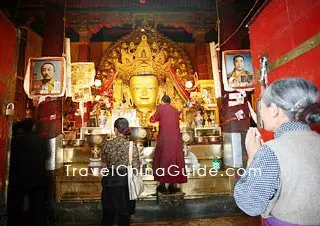 |
| People offer prayers in Tibetan New Year |
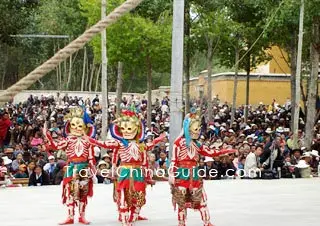 |
| Religious dance in Great Prayer Festival |
The Butter Lamp Festival, Chunga Choepa in local language, falls on the fifteenth day of the first Tibetan month. The event was also established by Tsong Khapa to celebrate the victory of Sakyamuni against heretics in a religious debate. Giant butter and Tsampa sculptures varying in forms of auspicious symbols and figures are displayed on Barkhor. People keep singing and dancing throughout the night.
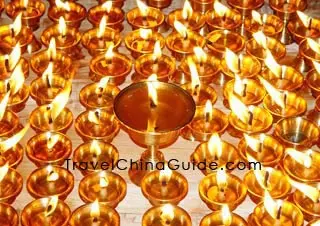 |
| Butter Lamp Festival |
Shoton Festival, also known as the Yoghurt Festival, begins on the thirtieth day of the sixth Tibetan month. The origin of it started from the 17th century when pilgrims served yoghurt to the monks who stopped for their summer retreat. Years later, local opera performances were added to the event to amuse monks in monasteries. During the occasion, giant Thangkas of the Buddha are unveiled in Drepung Monastery while the opera troupes perform at Norbulingka.
The Bathing Festival starts on the twenty-seventh day of the seventh lunar month and lasts a week when Venus appears in the sky. The locals bring food, set up tents along rivers and bathe themselves under the star light. The holy bath was believed to heal all kinds of illnesses and wards off misfortune.
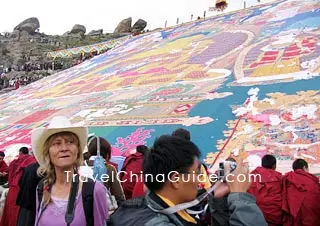 |
| Buddha Unfolding Festival |
There are different versions of the origin of Gyangtse Horse Rave Festival, which is also popular throughout the region. It usually falls in June. Horse race, archery contest, and other games are performed to entertain people. Religious activities also are part of the event.
Buddha Unfolding Festival is celebrated in Tashilhunpo Monastery from the fourteenth to the sixteenth day of the fifth Tibetan month. Unbelievable giant Thangkas of Amitayus, Sakyamuni and Maitreya are displayed on the monastery's Thangka Walls. Thousands of pilgrims rush to the monastery to give their offerings to the Buddhas for the accumulation of their merits. The tradition has lasted for 500 years.
![]() See Videos of Buddha Unfolding Festival
See Videos of Buddha Unfolding Festival
Tsong Khapa Butter Lamp Festival falls on twenty-fifth day of the tenth Tibetan month. It is an event when myriads of butter lamps are lit on rooftops with prayers chanted to commemorate the loss of Tsong Khapa who was a great religious reformer adept in Buddhism.
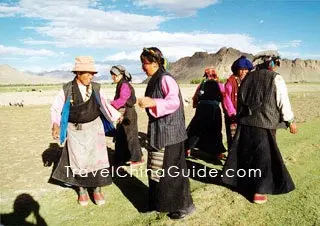 |
| Dance in the Harvest Festival |
Universal Prayers Festival (Zamling Chisang in local language) falls on the fifteenth day of the fifth Tibetan month. The event commemorates Padmasambhava's subjugation of evil spirits. People go to the monasteries to burn juniper branches.
Harvest Festival (Ongkor in local language) is celebrated when crops ripen, usually around August. It is observed only in farming villages. People walk around their fields to thank the gods and deities for a good year's harvest. Singing, dancing, and horseracing are indispensable folk activities.
![]() 2025 Celebration Date Contrast of Tibetan Festivals
2025 Celebration Date Contrast of Tibetan Festivals
| Festivals | Date Contrast | |
|---|---|---|
| Gregorian Calendar | Tibetan Calendar | |
| Tibetan New Year / Losar | Feb. 28 | Jan. 1 |
| Monlam Prayer Festival | Mar. 3 - 24 | Jan. 4 - 25 |
| Butter lamp / Choe-nga Choepa | Mar. 14 | Jan. 15 |
| Saga Dawa | Jun. 11 | Apr. 15 |
| Gyantse horse race | Jun. 5 - 23 | Apr. 10 - 28 |
| Thangka Unfolding in Tashilungpo Monastery | Jul. 9 - 11 | May 14 - 16 |
| Zamling Chisang / Samye Dolde | Jul. 10 | May 15 |
| Choekor Duechen / Tukbe Tseshi | Jul. 28 | Jun. 4 |
| Nagchu Horse Race | Aug. 1 | ---- |
| Ganden Thangka Unveiling | Aug. 9 | Jun. 15 |
| Shoton Festival | Aug. 23 - 24 | Jun. 29 - Jul. 1 |
| Labrang Rikda | Aug. 31 | Jul. 8 |
| Karma Dunba (Bathing Festival) | Aug. 29 - Sep. 4 | Jul. 6 - 12 |
| Lhabab Duechen | Nov. 11 | Sep. 22 |
| Palden Lhamo festival | Dec. 4 | Oct. 15 |
| Ganden Nga-Choe | Dec. 14 | Oct. 25 |
- Last updated on Aug. 15, 2025 by Demi Li -